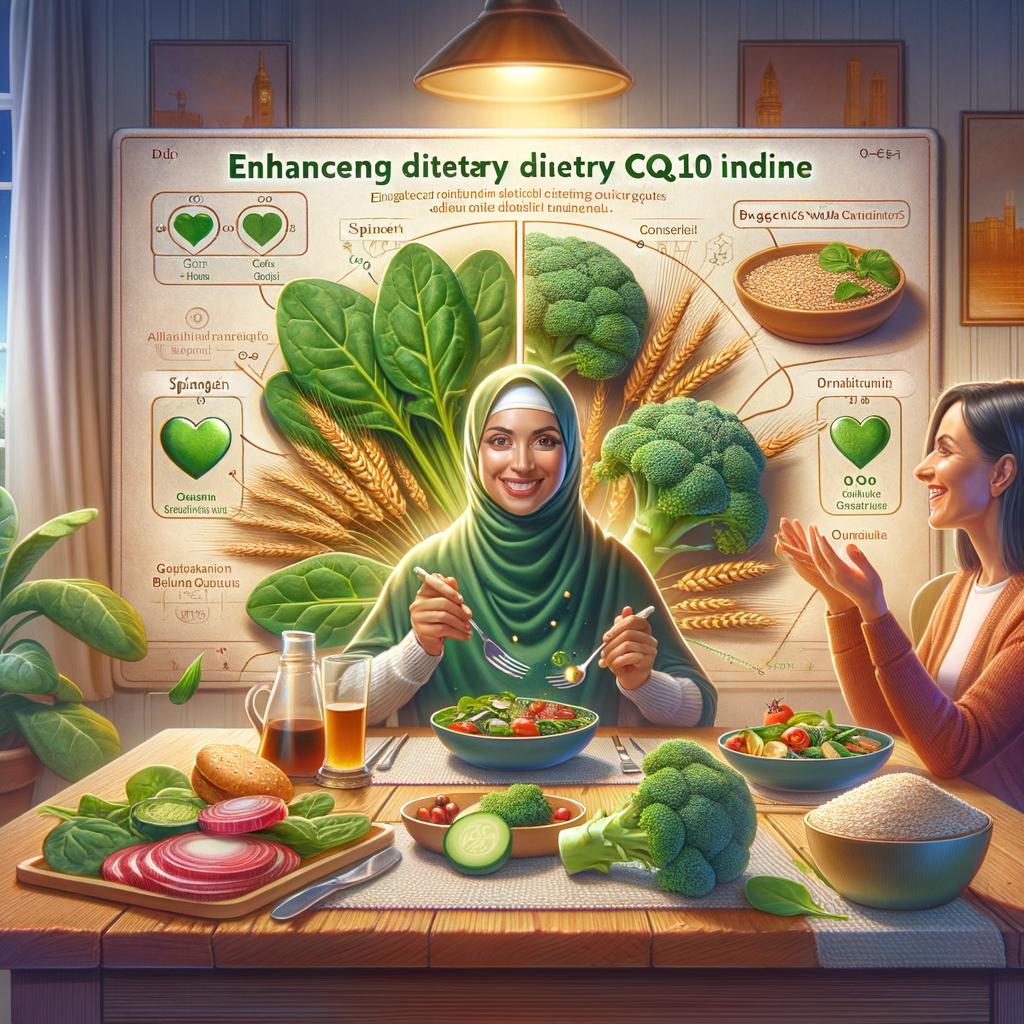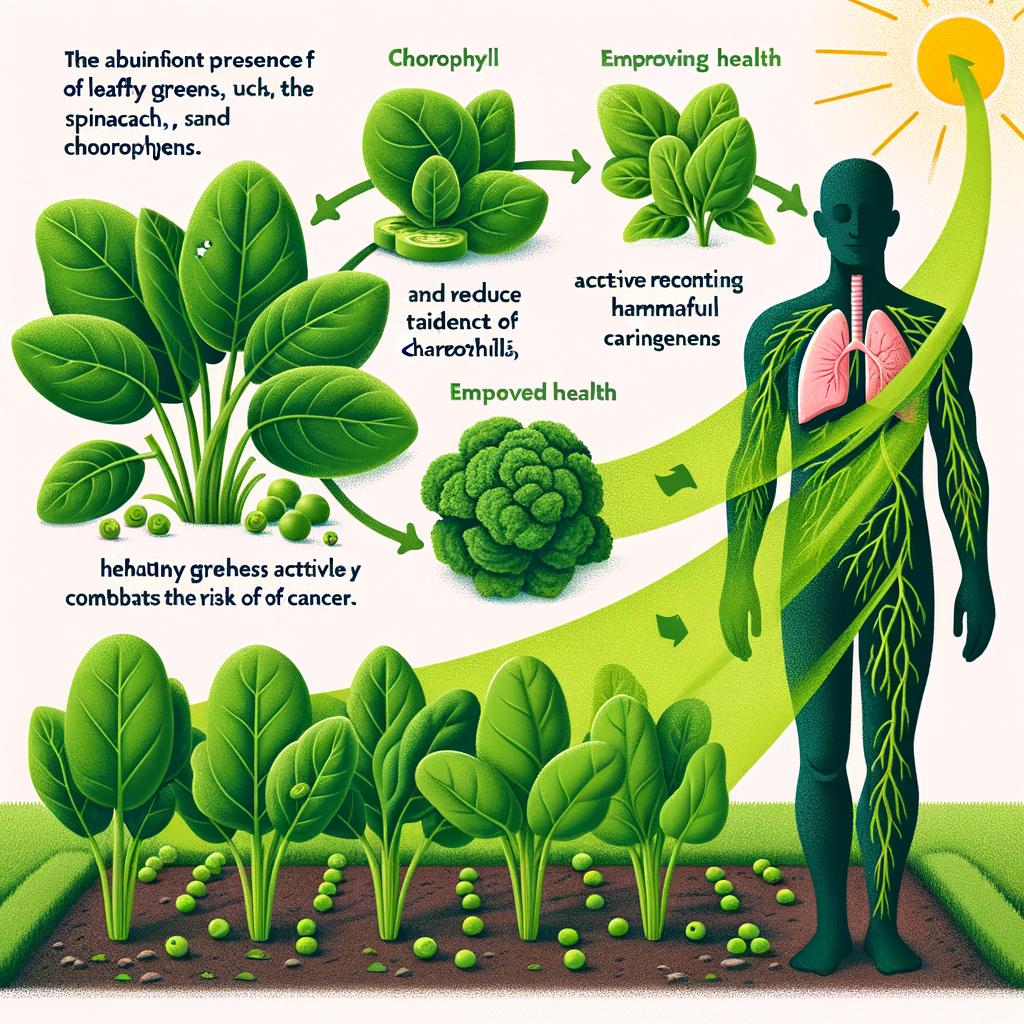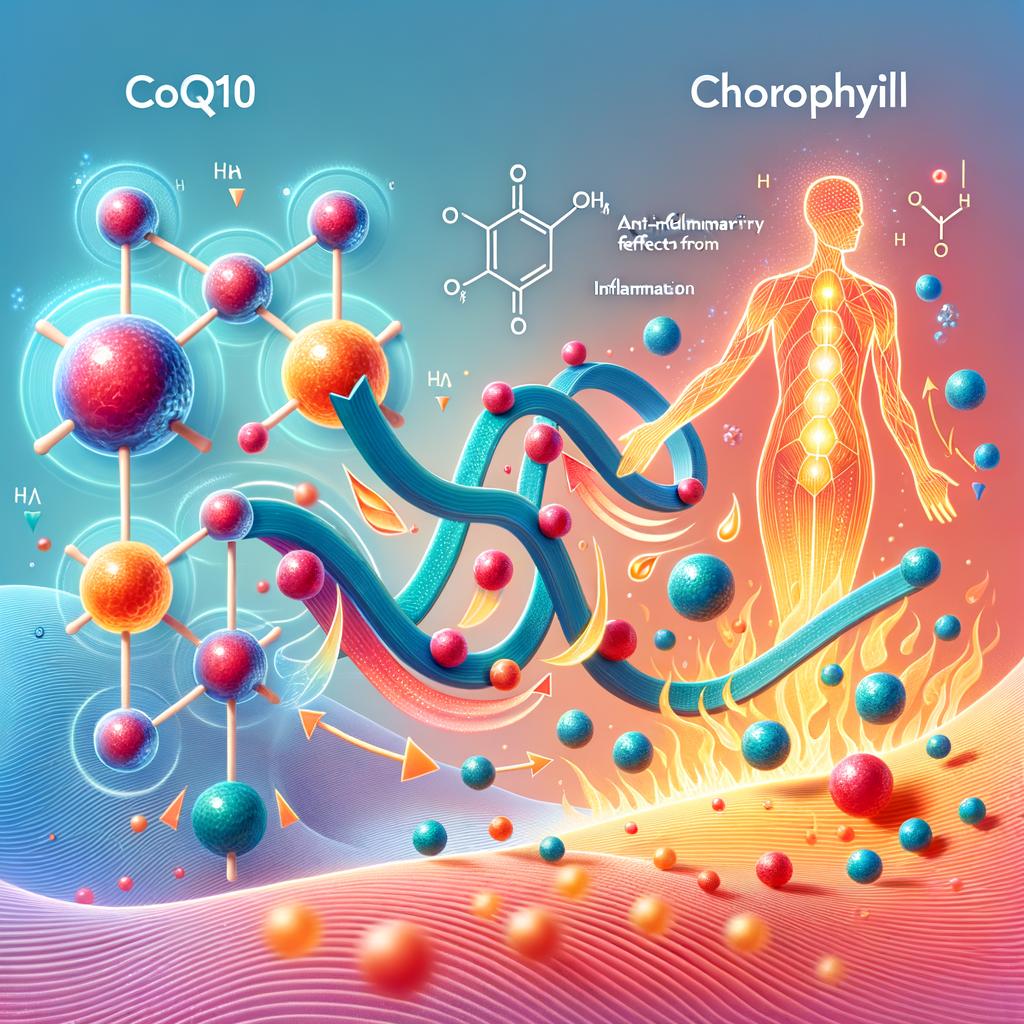Welcome to a new blog post inspired by a fascinating YouTube video titled “Rediscovering Vitality: Natural Ways to Reboost your CoQ10”. In a retracing journey through the essence of life, we dive into the understated marvel of chlorophyll – the vibrant pigment that bestows our greenery its lush allure - and its unexpected role as a detective of contamination in our food chain. Beyond its luminescent tracking abilities, chlorophyll’s potential health benefits include combatting inflammation and even rivaling carcinogens. Venture with us as we explore these contentions and delve into the natural rejuvenation of an essential component of our vitality – the Coenzyme Q10, the CoQ10.
Table of Contents
- Understanding the Role of Chlorophyll in CoQ10 Regeneration
- Revealing the Fluorescent Power of Chlorophyll in Managing CoQ10 Levels
- Implementing Dietary Changes: Enhancing CoQ10 through Greener Diets
- From Leafy Greens to Better Health: Chlorophyll’s Fight Against Carcinogens
- CoQ10 and Inflammation: Exploring the Anti-Inflammatory Benefits of Chlorophyll
- Q&A
- Key Takeaways
Understanding the Role of Chlorophyll in CoQ10 Regeneration
Unleashing the Power of Chlorophyll in CoQ10 Rejuvenation
Chlorophyll, known botanically as the green palette of leafy trees, has more to offer than just an appealing verdant hue. For those delving into the medical realm, a myriad of studies associate this green pigment with fecal fluorescence – a technique used to trace fecal contamination of carcasses in slaughterhouses and mitigate the risk of foodborne illness resulting from pathogens thriving in animal feces. When animals are grass-fed, the fecal matter becomes fluorescent under a black light due to the presence of chlorophyll. A chlorophyll solution, for instance, glows red under UV light. Hence, incorporating a black light in a chicken slaughterhouse could potentially lead to a drop in fecal contamination.
In today’s industrialised farming where free-range feeding is dwindling, fecal fluorescence is becoming less common. However, an innovative solution is adding chlorophyll supplements to animal feed as a way to detect the spots of gut contamination on meat more efficiently. Notably, integrating chlorophyll into the diet is more than just a tactic to track fecal contamination in slaughterhouses.
The Preventive and Protective Influence of Chlorophyll
The intimate link between Chlorophyll and cancer prevention sparked my interest in this green pigment. Various in-vitro studies support this claim, hinting at the possibility that chlorophyll may actually help block carcinogens. Among the additional benefits of chlorophyll are its potential anti-inflammatory effects. Incorporating green leafy vegetables into your diet, which are rich in chlorophyll, has long been recommended to manage inflammation, fortifying the therapeutic nature of chlorophyll and its compounds.
This discovery is particularly significant when considering the role of chlorophyll in the regeneration of Coenzyme Q10 (CoQ10). CoQ10 is a crucial molecule that fuels the powerhouse of cells and doubles as an antioxidant, warding off diseases triggered by harmful free radicals. Therefore, the natural ingestion of chlorophyll in one’s diet as a supplement transpires as a natural and beneficial channel to tap into the full potency of CoQ10 and regain vitality.
Revealing the Fluorescent Power of Chlorophyll in Managing CoQ10 Levels

While chlorophyll is widely recognized as the green pigment responsible for the vivid green color of plants, its beneficial effects serve far beyond its primary function in photosynthesis. A highly intriguing aspect is its ability to emit a brilliant red fluorescent light under UV radiation. Diving into the medical literature, one might find that Chlorophyll has been employed in the detection of fecal contamination in slaughterhouses to curtail food poisoning risks. It achieves this through fecal fluorescence, casting visible glow indicating contamination when exposed under UV light; a fascinating phenomenon, indeed!
The Health Benefits of Chlorophyll
“Surprisingly, the notion of consuming plants could hold an impressive edge in CoQ10 regeneration. The reason behind elucidating the properties of chlorophyll was to scrutinize its potential in blocking carcinogens. Data indeed suggests that consumption of green leafy vegetables could significantly reduce the likelihood of cancer. In addition to documentation on the potential anti-inflammatory effects of chlorophyll, consuming chlorophyll supplements can allow for efficient identification of gut contamination sites in meat – major players in the frequent food poisoning incidents. Since immemorial times, greens have been employed in inflammation treatment. Thus it is safe to conclude that the anti-inflammatory properties of chlorophyll and its products immensely contribute to wellness and vitality.
Implementing Dietary Changes: Enhancing CoQ10 through Greener Diets

Unearth the natural power of chlorophyll in “going green” to naturally regenerate coenzyme Q10 (CoQ10) levels in your body. Not only does chlorophyll give green leaves their vibrant hue, but it also plays a substantial role in nourishing our bodies. While many references to chlorophyll in medical literature relate to fecal fluorescence used for detecting animal carcass contamination in slaughterhouses and reducing food poisoning risk, there is far more to this green pigment.
If animals have been fed grass, this chlorophyll-laden diet lights up against a black light. This method is used to detect fecal contamination spots as under a UV light, chlorophyll glows red. Interestingly, this quality is not able to be exploited if chickens, for instance, are no longer allowed outside and do not eat grass. Instead, a chlorophyll supplement is added to their diet, enabling the same contamination detection to take place. However, these industrial uses should not deter one from the numerous health benefits associated with augmenting dietary intake of chlorophyll-rich foods.
Besides being an essential part of a green diet, which aids in mitigating the risk of cancer, chlorophyll can inhibit various carcinogens according to some in vitro studies. Such powerful properties of chlorophyll are instrumental in reducing inflammation within the body, proving why green leafy vegetables have long been an antidote for inflammation treatments.
So here’s a list of a few greens you can incorporate into your diet to enhance CoQ10 naturally:
- Spinach
- Broccoli
- Parsley
- Peas
In conclusion, making green leafy vegetables a staple in your meals could be a wise move towards harnessing chlorophyll’s potential anti-inflammatory and cancer-blocking benefits. It isn’t just an easy way to enhance your CoQ10 levels naturally, but it’s also a bold step towards a healthier lifestyle.
From Leafy Greens to Better Health: Chlorophyll’s Fight Against Carcinogens

Chlorophyll, the green pigment recognized for making leaves green, proves to have much more to offer than its aesthetic appeal. Going beyond its basic plant functionality, it exhibits astonishingly immense beneficial impacts on human health. Surprisingly, even on a seemingly unrelated matter like fecal matter contamination! Rippling across the food industry, it is becoming instrumental in detecting fecal contamination in slaughterhouses that can gravely risk food poisoning due to pathogens blooming in animal waste. One might ask, how? When animals that have ingested grass enter the slaughterhouse, their fecal matter can become luminescent under a black light due to the presence of chlorophyll. This aids in isolating the tainted portions, significantly reducing the risk.
But what does it imply when the animals don’t graze anymore?
Unfortunately, the identification of contamination becomes difficult. But, chlorophyll comes to the rescue here too, remarkably showcasing its adaptable nature. Supplementing chlorophyll in the animal’s feed can serve the purpose just as well, lighting up under UV light, ensuring safe food.
A deeper analysis reveals yet another astonishing advantage of chlorophyll – its potential in blocking carcinogens. Multiple in-vitro studies provide evidence of chlorophyll’s potential anti-inflammatory effects in addition to its ability to combat cancer. These potential health benefits reaffirm the age-old practice of consuming leafy greens for treating inflammation, laying testament to the potency of chlorophyll and its products.
CoQ10 and Inflammation: Exploring the Anti-Inflammatory Benefits of Chlorophyll

When we delve into the natural regeneration of Coenzyme Q10 (CoQ10), one oft-overlooked component that stands out is chlorophyll. This green pigment, responsible for the verdant hues we associate with healthy vegetation, has been traditionally prized for its various health benefits. Interestingly, most medical literature associates chlorophyll with fecal fluorescence – a method of detecting fecal contamination in slaughterhouses to reduce the risk of food poisoning from pathogens in animal feces.
The contamination usually takes place when fecal matters inadvertently come into contact with the meat or penetrate carcasses through a cut. While this information might not appear relevant to our exploration of CoQ10 and inflammation, it serves to highlight the diverse and complex role chlorophyll plays in our health.
Animal feces can be traced effectively when the animals are fed grass, as fecal matter under ultraviolet (UV) light exhibits fluorescence. A chlorophyll solution, under the UV light, glows red. Hence, equipped with a UV light in a chicken slaughterhouse, the fecal contamination can be traced effectively. However, a predicament arises when poultry is no longer permitted outdoors and consequently, fed less grass, leading to decreased fecal fluorescence.
One way to circumvent this obstacle is through the supplementation of chlorophyll into their feed, allowing for efficient detection of contamination on the meat. It is interesting to note that chlorophyll was originally explored to parse its potential anti-carcinogenic properties, a topic covered in the video, “Eat Leafy Greens to Prevent Cancer”. This exploration, however, opened doors to multiple in-vitro studies pointing to the anti-inflammatory effects of chlorophyll. This insight taps into the time-honoured tradition of using leafy greens in addressing inflammation, underscoring the anti-inflammatory properties of chlorophyll and its derivatives.
Q&A
Q: How can we naturally regenerate Coenzyme Q10 (CoQ10)?
A: Chlorophyll, the green pigment that makes green leaves green, can help in regenerating CoQ10 naturally. Chlorophyll can be found in medical literature, although much of it is about fecal fluorescence, a method for detecting fecal contamination in the slaughterhouse to reduce the risk of food poisoning from pathogens found in animal feces. Fecal matter can reach the meat either through the skin or in the air when the skin is peeled. However, if animals have been fed grass, you can observe it as black light. This is a chlorophyll solution. Under UV light, chlorophyll fluoresces red. Therefore, if you have black light in a chicken slaughterhouse, you can see a decrease in fecal fluorescence. The problem is that chickens are not allowed to go outside anymore. They no longer graze on grass, resulting in less fecal fluorescence. We can let them run around, but it would be cost-effective to simply add chlorophyll supplements to their feed to better identify fecal contamination on the meat. The reason why I examined chlorophyll was to follow up on the data I presented in my video “Eat Leafy Greens to Prevent Cancer,” which suggested that chlorophyll may block carcinogens. There are several in vitro studies I found that support the potential anti-inflammatory effects of chlorophyll. Ultimately, leafy greens have long been used to treat inflammation, so the anti-inflammatory properties of chlorophyll and its products are noteworthy.
Key Takeaways
As we journey back to the essence of nature, let us remember to nourish our cells with the green gift of chlorophyll, nature’s powerhouse for vitality. Our deep-dive into the benefits of this green pigment, from grass-fed animals to leafy greens, has shown its potential in both food safety and health outcomes.
Despite its unfortunate association with fecal contamination detection in slaughterhouses, the glow of chlorophyll under black light is a symbol of vitality, a beacon guiding us towards cleaner, healthier meat options. Meanwhile, our exploration of dietary chlorophyll has illuminated its potential to block carcinogens and provide potent anti-inflammatory effects. It seems the radiant sheen of fresh green leaves might just hold the secret to reigniting our CoQ10 and boosting our vitality.
So let’s embrace this shot of green energy in our diets, to harness nature’s potential in safeguarding our health. Remember, chlorophyll’s power does not lie just in brightening our plates but also in enriching our lives with the strength of nature. As we conclude our journey, let’s carry the essence of chlorophyll with us, as a reminder of the natural, radiant vitality that can be sown within us. Here’s to better health and a brighter future, nurtured by the exquisite power of nature.



